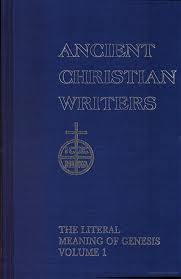De Genesi ad Litteram in St. Augustine: The Literal Meaning of Genesis, Trans., John H. Taylor. Long Prairie: Newman Press 1982
Excerpt:
”
CHAPTER 1
The interpretation of Scripture. The meaning of heaven and earth.
1. Sacred Scripture, taken as a whole, is divided into two parts, as our Lord intimates
when He says:
”A scribe instructed in the kingdom of God is like a householder who brings forth from
his storeroom things new and old.”1
These new and old things are also called testaments.
In all the sacred books, we should consider the eternal truths that are taught, the facts
that are narrated, the future events
that are predicted, and the precepts or counsels that are given. In the case of a narrative of
events, the question arises as
to whether everything must be taken according to the figurative sense only, or whether it
must be expounded and
defended also as a faithful record of what happened. No Christian will dare say that the
narrative must not be taken in
a figurative sense. For St. Paul says: “Now all these things that happened to them were
symbolic.”2 And he explains
the statement in Genesis, “And they shall be two in one flesh,”3 as a great mystery in
reference to Christ and to the Church.4
2. If, then, Scripture is to be explained under both aspects, what meaning other than the
allegorical have
the words: “In the beginning God created heaven and earth?”5 Were heaven and earth
made in the
beginning of time, or first of all in creation, or in the Beginning who is the Word, the
only-begotten Son of God?
And how can it be demonstrated that God, without any change in Himself, produces
effects subject to change and
measured by time? And what is meant by the phrase “heaven and earth”? Was this
expression used to indicate spiritual and corporeal creatures? Or does it refer only to the corporeal, so that we may presume in this book that the author passed over in silence the
creation of spiritual beings, and in saying “heaven and earth” wished to indicate all
corporeal creation above and below? Or is the unformed matter of both the spiritual and
corporeal worlds meant in the expression “heaven and earth”: that is, are we to
understand, on the one hand, the life of the spirit as it can exist in itself when not turned
towards its Creator (it is by this turning towards its Creator that it receives its form and
perfection and if it does not thus turn, it is unformed);6 and, on the other hand, bodily
matter considered as lacking all the bodily qualities that appear in formed matter when it
is endowed with bodily appearances perceptible by the sight and other senses?7″
Online:
Amazon
Free edition (excerpt)
